Top 5 Native Flowering Trees of Central Texas
If you are looking for a new tree to add to your yard, go native! These five flowering trees of Central Texas are not only native to the Hill Country area, they are absolutely gorgeous when they are in bloom.
Be sure to download my free printable PDF of 5 Texas Flowering Trees. You can take this handy one-pager with you to the plant nursery.
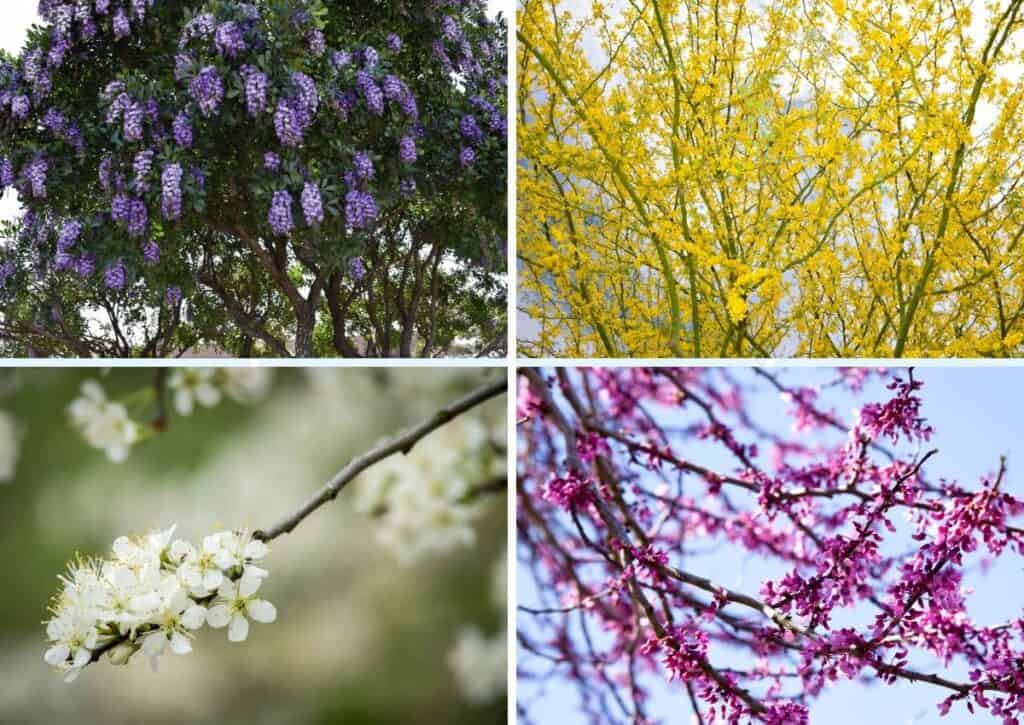
Why Plant Native Texas Trees?
Did you know that native trees (those that have evolved in your local area) can offer a wealth of ecological benefits over non-native trees (those imported from other continents)? Native trees:
- Are some of the best butterfly and moth host plants that we have. Learn why host plants are so important to sustaining wildlife.
- Have evolved in your local climate and tend to handle harsh weather conditions such as long periods of drought better than non-natives.
- Create a sense of place. Nothing says Texas Hill Country like the Texas Mountain Laurel in bloom!
- Provide ecological diversity from the monotony of yards planted with the same non-native species (i.e., all those Crepe Myrtles and Ligustrum trees!).
5 Flowering Trees of Texas Hill Country
There are more native flowering trees of Texas than just these five , but these are my favorite ornamental trees around San Antonio where I live. What would you add to the list?
1. Texas Mountain Laurel
Scientific Name: Sophora secundiflora
Often referred to as the “Grape Kool-Aid Tree”, this one of the first trees flowering in Central Texas in the spring, and its flowers really do smell like grape Kool-Aid! The small tree has beautiful cone shaped clusters of purple flowers that are 3-7″ long.
The flowers only last a few weeks in spring, but the remainder of the year the evergreen tree has pretty glossy leaves.
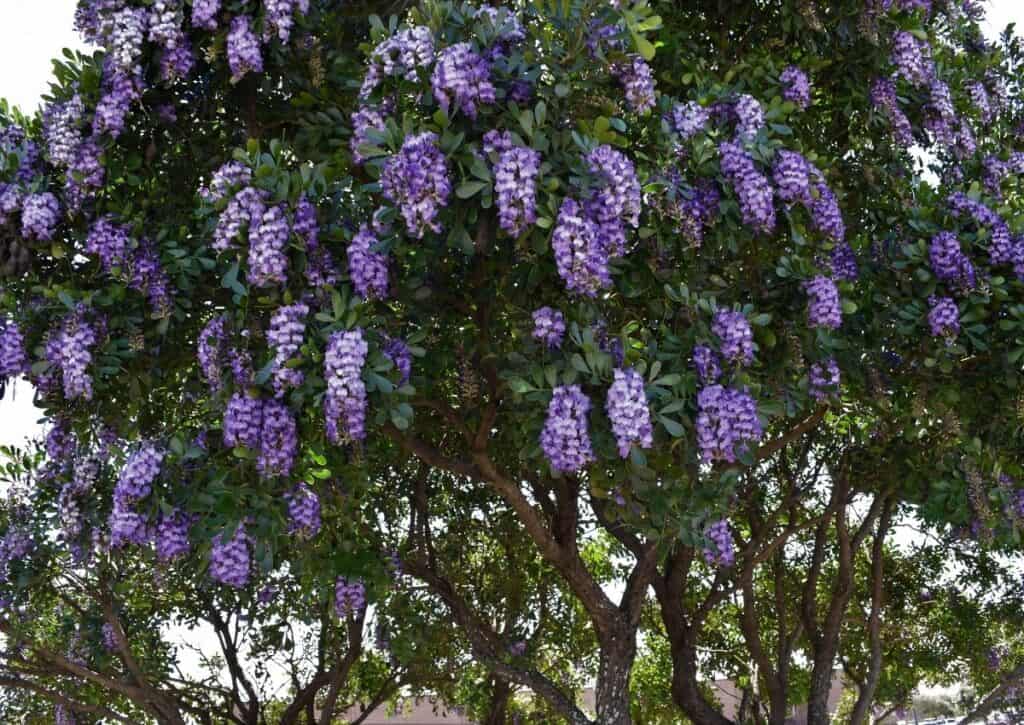
Mountain Laurel Tree Details
- Blooms: Purple blooms in early spring (Feb-April)
- Height: 6-12 ft.
- Sun Requirements: Dappled shade to full sun
- Common Names: Texas Mountain Laurel, Mescal Bean
- Host Plant: Henry’s Elfin and Orange Sulphur butterflies
Did You Know?
The bright red Mescal beans (seeds) of the Texas Mountain Laurel were used by Native Americans for ceremonial uses. However, the beans can be deadly to humans if broken and chewed. Thankfully, their hard seed coat means that if a child accidentally swallows a bean it will most likely pass through their system without causing harm.
2. Texas Redbud
Scientific Name: Cercis Canadensis var. texensis
This is one of the pretties blooming trees in Texas and hard to miss when it is in bloom. Its branches are covered in purplish pink flowers between March and April. It is one of the most recognizable flowering trees of Central Texas and commonly used in landscapes. I also personally think it is the prettiest flowering tree in Texas!
The rest of the year you can identify the plant by its heart shaped leaf. However, it is a deciduous tree. The leaves will turn yellow and fall from the tree in the winter.
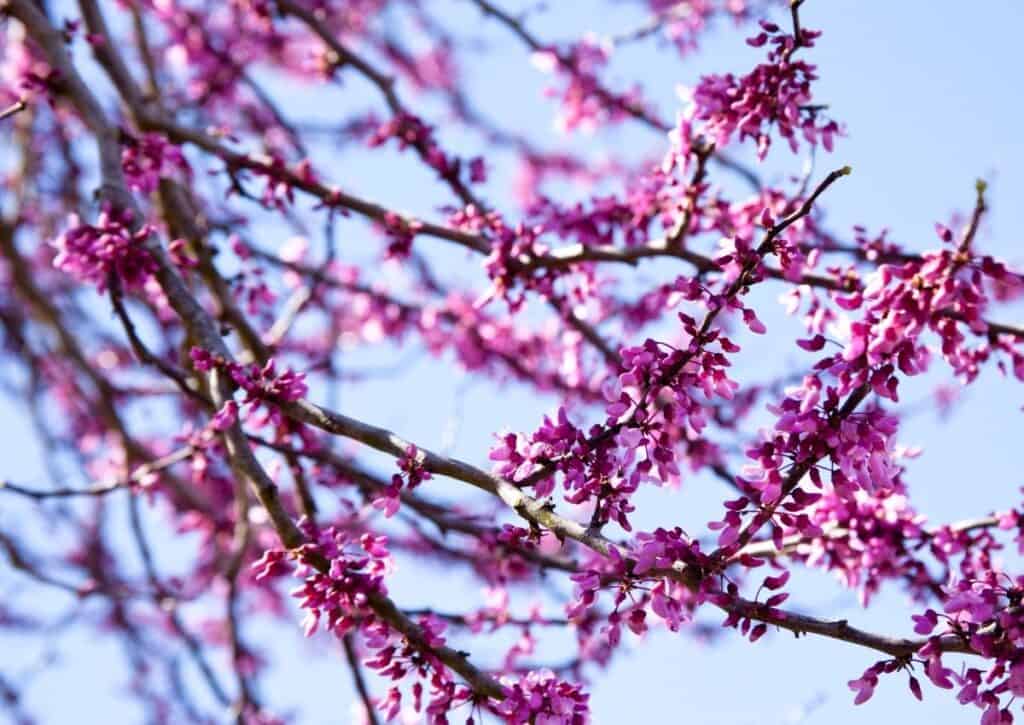
Texas Redbud Tree Details
- Blooms: pinkish purple blooms cover branches in March & April
- Height: 10-20 ft.
- Sun Requirements: Dappled shade to full sun
- Common Names: Texas Red Bud (different from Eastern Red Bud)
- Host Plant: Henry’s Elfin butterfly
Did You Know?
You can eat the flower buds and flowers of the Texas Redbud. Apparently, they are especially delicious sautéed in butter! The cut branches also make for a beautiful spring arrangement.
3. Huisache
Scientific Name: Vachellia farnesiana
For several years I loved eating at the Huisache Grill in New Braunfels, without knowing what “Huisache” meant. It is pronounced “WEE-satch”. Only recently did I realize it was the name of a native Texas tree with beautiful puff balls of yellow flowers in the spring!
The flowers put off a heavenly scent. However, in some areas the tree may not bloom every year if the flower buds are hit by a late frost. I’m guessing they will not bloom this year given the February 2021 Snowcopalypse.
Other identifiable characteristics of Huisache are its multiple trunks and skinny branches with thorns and fern-like leaves. Huisache actually means “many thorns” in Nahuatl – a language spoken by the indigenous people of Mexico.
Huisache Tree Details
- Blooms: golden yellow ball-shaped blossoms from March-April
- Height: 15-20 ft.
- Sun Requirements: Full sun
- Common Names: Huisache, Sweet Acacia
- Host Plant: Henry’s Elfin butterfly
Did You Know?
They plant this tree in Southern Europe to be used for perfume. I love this tree but it can be considered invasive as it will easily move into disturbed areas. However it is a great provider of nectar for bees and seeds for birds!
4. Retama
Scientific Name: Parinsonia aculeata
This is another name that I associated with a business around San Antonio without knowing what it meant -the Retama Park horse race track! Retama is one of several common names for this pretty drought tolerant tree with lime green branches and bright yellow flowers. This tree can be found from Southern Texas to Arizona, where it is called Palo Verde.
We have a Retama tree on the nature path near our house. I am keeping a close eye on it as it looks like it was damaged from the February mega-freeze.
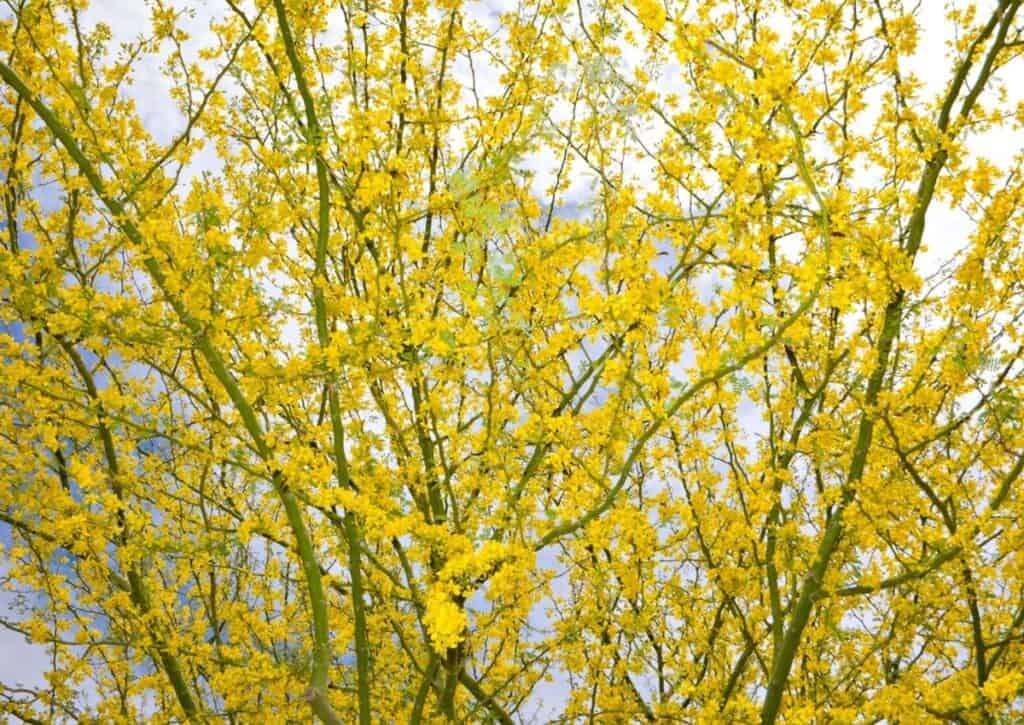
Retama Tree Details
- Blooms: Clusters of bright yellow from from spring-summer
- Height: 12-15 ft.
- Sun Requirements: Full sun
- Common Names: Retama, Palo Verde, Jerusalem Thorn
Did You Know?
Retama likes soil that is not too wet or too dry. Under very dry conditions, it will drop all its leaves. However it still looks pretty with its green branches. Its long bloom cycle makes it a great nectar source for pollinators. Its seeds provide food for birds and small mammals.
5. Mexican Plum
Scientific Name: Prunus Mexicana
I saw this tree in bloom for the first time on the grounds of Mission San Juan while on a nature walk with Master Naturalists. It was in early February and one of the first trees in bloom. It was covered with bees!
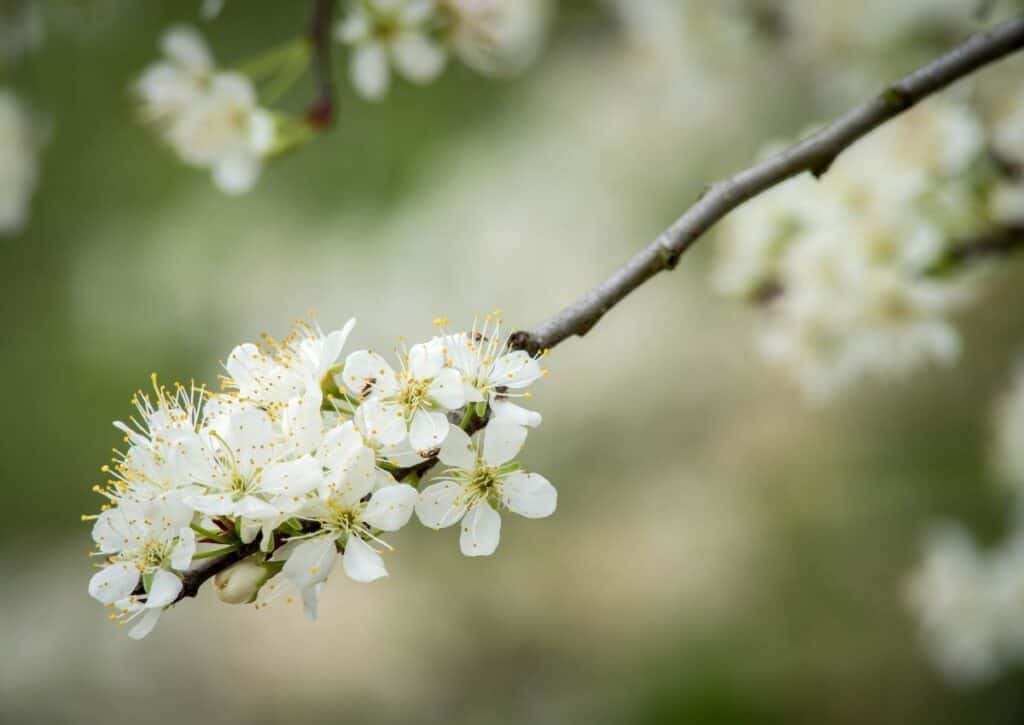
Mexican Plum Tree Details
- Blooms: Pretty white blooms cover its branches in early spring (Feb – April)
- Height: 15-35 ft.
- Sun Requirements: Dappled shade to full sun
- Common Names: Mexican Plum, Bigtree Plum
- Host Plant: Tiger Swallowtail, Cecropia Moth, Large Tolype Moth
Did You Know?
Not only do the bees love its flowers, the plums are devoured by birds and other small mammals. Humans can eat them too!
Download the Free PDF: 5 Texas Flowering Trees
I created a handy one-page PDF for you to print and take with you to the plant nursery. It includes a thumbnail photo of each plant along with its common and scientific names, size, sun needs and more! Get it here:
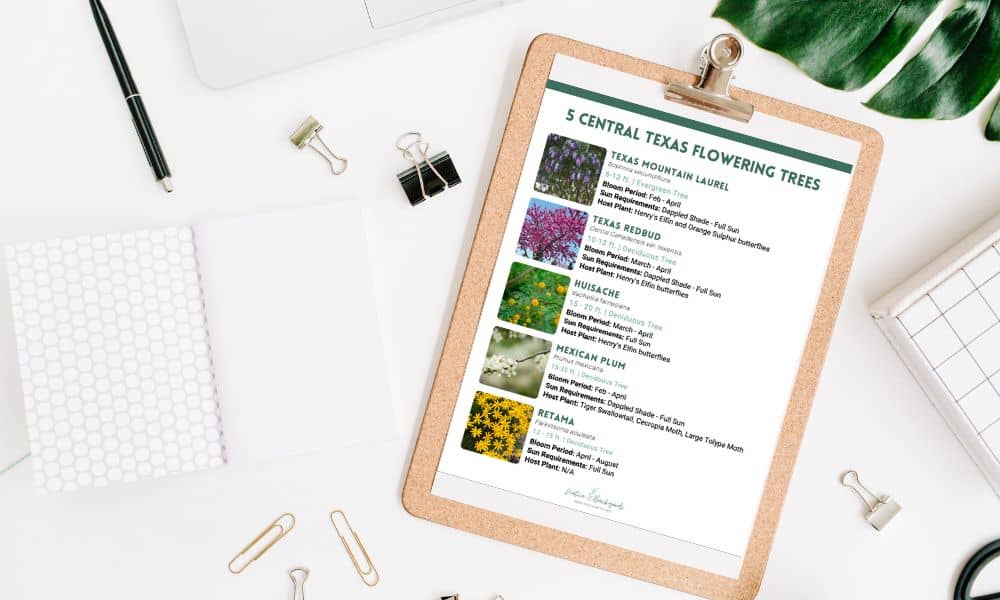
How Do I Identify a Flowering Tree?
See a tree flowering in the spring but aren’t sure what it is? The easiest way to find out is to take a few photos of it and upload it to a plant identification app. My favorite is iNaturalist. Not only will it tell you what the plant is, it will tell you where it is native to.
Get my tips for identifying plants with an app:
Pin this to spread the word about Texas native trees!

This post contains affiliate links. See our full disclosure.
Sources referenced for this article:
- Native Texas Plants: Landscaping Region by Region (one of my favorite TX native plant books!)
- Trees, Shrubs, and Vines from the Texas Hill Country (a must if you live in the Hill Country)
- Wildflower.org (a great online database of native Texas plants)

Welcome to Native Backyards! I’m Haeley from San Antonio, Texas, and I want to help you grow more native plants.
I have seen firsthand how the right plants can bring your yard to life with butterflies, bees, and birds. I’ve transformed my yard with Texas natives and I’m excited to share what I’ve learned with you.
Join my newsletter here! – each week I’ll send you helpful tips to make your native plant garden a reality!
Want to learn more about me and my garden? Check out my About page!

I wanted to get a Huisache/Sweet Acacia sapling. There is nothing listed on the Ladybird Johnson Wildflower site. When googling all I could find where seeds or little 3 inch tall…I guess you could call them saplings? Priced between $7.00 and$16. Was hoping for something a bit more mature priced up to $50. Can you help me with find a Huisache that might produce flowers in maybe 5 or 10 years. (Would prefer 2-3 years)
Hi Sylvia! Thanks for your comment. I had to do a bit of asking around to help with your question. It sounds like native plant nurseries like Rainbow Gardens here in San Antonio will carry huisache, but that their stock got damaged significantly in the Feb. freeze so many don’t have any right now. I say go with a sapling if you can get one, as they are fast growing trees. Or keep a lookout at nurseries in the fall. They may have some by then. Good luck!
My backyard is a barren piece of dirt. I need to plant trees. The soil is awful. Clay and rocks. I have planted an Esparza and Pride of Barbados and it is taking forever to get established especially with the February freeze last year. I want to stop the erosion. There are only weeds and no grass planted but I do not want grass but more of a park like feel for the yard. I’m reading a book Natures Best Hope. Private work in homes creating small parks on the private land. There is shade along the back fence line. Some kind of wild trees grow on the other side of the fence. I have no clue what they are. The backyard is spacious and gets extreme heat in the summer killing off the weeds creating a barren area. Needless to say it is depressing. I know I need to plant something in the barren area along with the tree (s) but my concern is picking the best tree for such extreme conditions. I can trim back the other trees along the fence some I wish I knew what they are. Invasive probably. Thank you
Hi Rebecca, thanks so much for your note! That is awesome you are trying to improve your backyard and you are reading one of the most inspirational books out there! Good work! Do you live in Texas? Let me know what part and I can send you some potential plant lists. Frogfruit would be a great groundcover to get started this fall. It is one of my favorites for attracting tiny pollinators and it likes full sun. Here is some info on it: https://nativebackyards.com/frog-fruit/. As for the trees, I recommend downloading a plant ID app to your phone. They are really good for identifying mystery plants. For a tree you want to get a photo of the full tree, as well as closeups of the bark and leaves. If you need help, send me some pics. I bet there are lots of tough native trees that would work well in your yard.
Hi Haeley,
We are currently building a house in Dripping Springs and I want to get a head start on planting some flowering native trees. I also have an apple tree my daughter started from seed when she was 4 years old. I do not know what kind of apple tree it is, but I am curious about the best way to care for it, especially since she is 16 now.
Thank You,
Thomas
Hi Thomas,
Thanks so much for your note, and I apologize for the delayed response! That is so neat that you have been nurturing an apple tree for the past 12 years. Has it produced good fruit? I admittedly don’t have any experience with apple trees so can’t be very helpful there. However, I did find this article by Texas Agrilife that looks like it could have some helpful info for you: https://aggie-horticulture.tamu.edu/extension/homefruit/apple/apple.html. Best of luck with the building of your new home! – Haeley
Haeley…enjoying your article on native trees and shrubs. Though my wife and I are native Texans, we have been away for more than 50 years…now living in Abilene, Texas. I am going with a straw bale garden, and am trying to grow vegetables…challenging. As to trees, I would like your opinion on what fruit trees will grow well here on the edge of the desert.
Hi Thos, I’m so glad you are enjoying my articles. I’m glad you’re exploring growing Texas natives! I am not well versed in fruit trees, so I don’t have any advice for you, but I did find this article that may help: https://lazygardener.co/2017/01/04/recommended-fruit-tree-varieties-for-different-regions-of-texas/
Will the Texas Red Bud (its beautiful) survive in West Texas. I live in Fluvanna Texas (45 minutes south of Lubbock )
Hi Deborah – thanks for your question about the Texas Redbud. Based on this BONAP map, it is found in your part of the state (signified by dark green), and perhaps even native to your particular area (signified by light green), so I say it is definitely worth trying! https://cdn.shopify.com/s/files/1/0305/7397/files/Cercis_canadensis_var._texensis.png?v=1628621534
Beautiful tree selections. I found this information on the Texas A & M Agri Life Extension office website. Why are they calling the Huisache tree invasive? Is it just old information? Is it a different plant? If the tree is native, beautiful and valuable to wildlife, then how can it also be invasive?
“Huisache is a common plant on rangeland and pasture in the eastern half of Texas. It is a tough, aggressive, invasive species that limits forage production and decreases the value of the wildlife habitat.”
I would like to plant one, but I live in a rural area near a lot of cattle ranches, I don’t want to create a problem for my neighbors. I’m in central TX, Washington County.
thank you
Hi Liz, thanks for your question! You raise a good point. Huisache is a native species so technically it can’t be invasive (which is a term reserved for non-native species), but it can be aggressive! From a rancher’s perspective, it can be a nuisance. Just like our native Ashe Juniper (Cedar) trees. They can be aggressive in disturbed areas. However, both of them offer important ecosystem benefits, so there are trade-offs. Perhaps try a Texas Mountain Laurel or Texas Redbud instead!